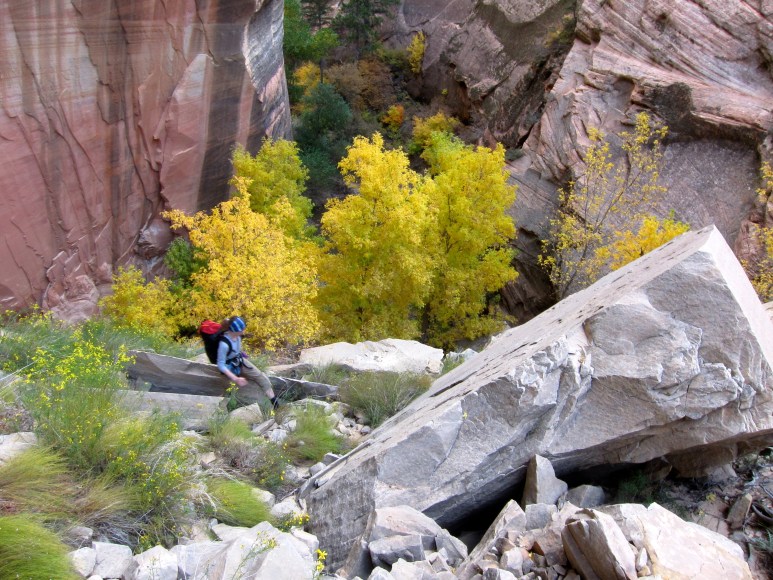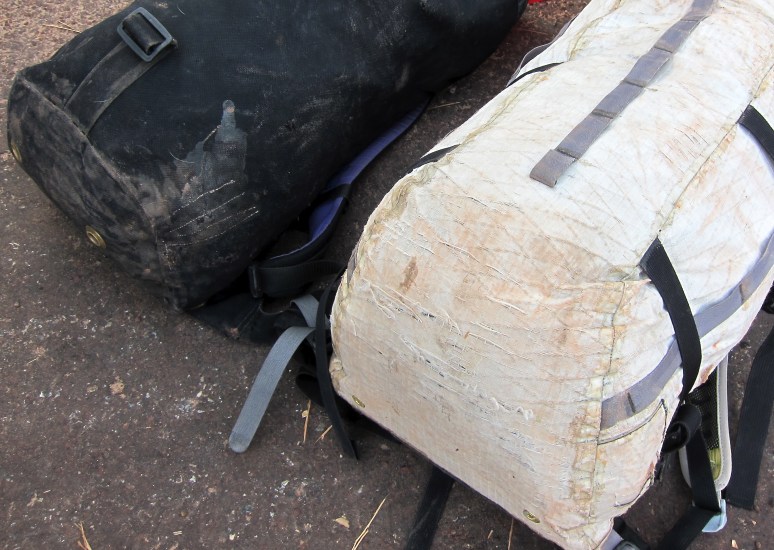First: hiking with ropes in Colorado Plateau canyons is probably the most satisfying thing you can do outside. The best parts of hiking, backpacking, rock climbing, and aid climbing are combined in an activity that’s hard enough to not just be fun, varied enough to not be monotonous, and technical enough to be intellectually engaging, yet with remarkably little tedium. And you get up close and very personal with the most interesting natural features on earth. There are many people who all but abandon, at least for a time, other outdoor “sports” once they’ve gone hiking with ropes in Colorado Plateau canyons.
Americans call it canyoneering. Europeans can it canyoning. I’ve always preferred the more pedestrian hiking with ropes, and canyoneering sounds a bit too grandiose for an activity which breaks stuff and stains your underwear with such regularity. The term canyoneering goes back at least into the 80s, and appears to have originally applied as much to the rugged, non-technical canyon hikes and backpacks such as the Zion Narrows and Buckskin-Pariah as the rap and squeeze fests in Zion and the Escalante.
I propose that canyoneering be seen as the logical inverse of and spiritual cousin to mountaineering. Back before alpine climbing became a separate cultural entity, mountaineering bespoke a holistic way of traveling through and experiencing the mountains. Trail pounding, camping, talus slogging, rock, ice, and snow climbing, ropework, and navigation were all part of the game, with pure difficulty well down the list of priorities. The best thing about most Colorado Plateau canyons is the big hikes required to get to them. The best thing about canyoneering is probably the ways in which aesthetics do not correlate with difficulty in any predictable manner, thus partially discouraging the climber’s disease of equating hard with better.
Canyoning can then be seen as equivalent to climbing, where kinesthetic purity and the craft of the difficult are prioritized above all other things. Canyoning would be a better term for the hard but plain Mae West slots currently in vogue, the easy access slots in North Wash (for example), and perhaps the bolted, “sport canyons” in Zion.
Canyoneering shares something with packrafting: it is both inviting of and dangerous for beginners. In climbing and mountaineering, you need to apply skill fairly early on to get far off the ground. In whitewater kayaking, you need to be able to keep your boat upright to get through the boogie water. The learning curves of packrafting and canyoneering are flat enough initially, and the intrusion of problems which require graduate-level wilderness judgment abrupt enough, that it is easy for people to get themselves killed. And in the last decade, lots of people have gotten themselves killed canyoneering, a trend which will probably continue.
A background in multi-day wilderness travel, especially in challenging environs, is thus an ideal base to learn to hike with ropes. It’s helpful to add the skillset of a low-intermediate rock climber (i.e. able to lead difficult to protect 5.9 routes). Given these things, canyon-specific skills follow quickly.
Delightfully, the gear required for most Colorado Plateau canyons is quite modest. The rule to keep in mind is that you’ll entering into the most abusive gear environment on the planet. Canyons which are narrow, wet, and sandy will impart several lifetimes of normal backpacking wear in a matter of hours.
As seen above, packs will get thrashed. At left, and in many of the photos featured in recent posts, if our trusty Cold Cold World Ozone. It’s a simple sack with a webbing waistbelt, good shoulder straps, and 100% 1650 denier ballistics body. As can be seen, this material is not overkill. I used it as our big pack in Shenanigans, and put a few holes in it in the process. Seam grip is your friend here. The bottom of my Black and White pack, above at right, also took a beating. Even wonder fabrics like DX40 shudder at the entrance to a slot. This points to the fact that 4-500 denier fabrics are the starting point for a canyon pack, with heavier being better for frequent use. Good canyoneering pack options still don’t exist, especially for multi-day stuff. The stock Ozone torso length is a bit short for most, but if Mr. Rackliffe is still doing custom stuff that would be a good option. Other climbing packs like the Black Diamond Demon are not bad. Imlay Canyon Gear makes very solid canyon-specific packs, but they have too many bells and whistles, a frame which is far too heavy for the support it gives, and a one-size fits all approach which is absurd. They are a good deal, however. Making your own or buying cheap ones from Sierra Trading Post (and cutting stuff off) remain the best options. Put plenty of drain grommets in the bottom.
Hardware for canyoneering is pleasantly minimal. I bring an ATC with biner, two addition lockers (Petzl Attaches have a good shape and a locking mechanism which deals well with sand), another locker carrying two prusiks and a shoulder-length dyneema runner, and a Metolius easy daisy with yet another locker. ATCs aren’t as smooth and adaptable as the various fancy figure 8s (e.g Petzl Pirana), but are much cheaper, last longer, and don’t twist the rope. Prusiks are lighter, cheaper, and far more functional than the various mechanical ascenders. You can prusik on dual strands, for instance. The easy daisy isn’t runner strength, but I’m comfortable using it as a chicken sling for raps, and the adjustable length is very handy, especially when aiding out of stuff. Speaking of which, I have an alpine aider, 2 Talons, an Ibis hook, potshots, and a bolt kit, but that stuff hardly ever gets taken along. There is no reason to use anything but an Alpine Bod for canyoneering (or perhaps the fancy new Couloir, but cut off the belay loop). They’re comfortable enough for the final rap sequence of Heaps, which is all you should ever need. Light and cheap is right.
Wetsuits will be necessary. A full 4 or 5mm will work for most stuff. Capilene and fleece worn under the suit adds warmth, as does a windproof vest of some kind (neoprene is not wind resistant). A farmer john and jacket combo is versatile, but layered neo is not as warm as the same thickness in one full layer. Wetsuits, like everything, will get killed fast. Buy on discount, used, etc. My main, 9 year old suit is a womens size 14 I bought for 50 dollars. It fits a bit odd in spots, but gets the job done.
Lastly, a comment on helmets. It has become de rigeur to wear helmets for all technical canyon hiking. In many instances this is a good idea, especially when pulling your ropes on big entrance raps down walls which haven’t been scoured clean by floods. In other circumstances the need is less acute. Canyons, even non-trade ones, tend to be pretty darn clean. There’s certainly the possibility of falling and hitting your head, but that risk is only slightly more likely while downclimbing than while hiking around. I prefer to simply not fall. Of course, social hikers who do lots of downclimbing and rapping with big groups are more likely to get a water bottle dropped on them, and might do well to wear helmets more often. Finally, many canyons are tight enough that a helmet is just one more thing to get stuck, and are thus probably more a liability than anything.
Hiking with ropes, get into it.



Leave a comment